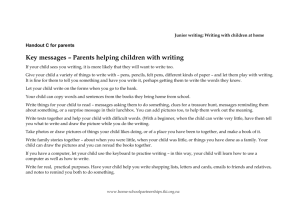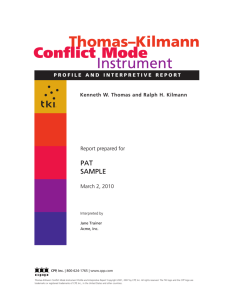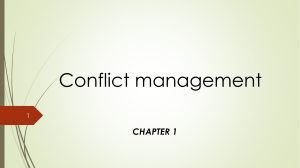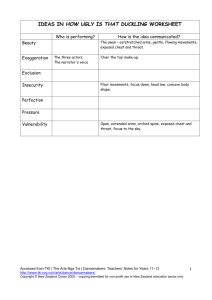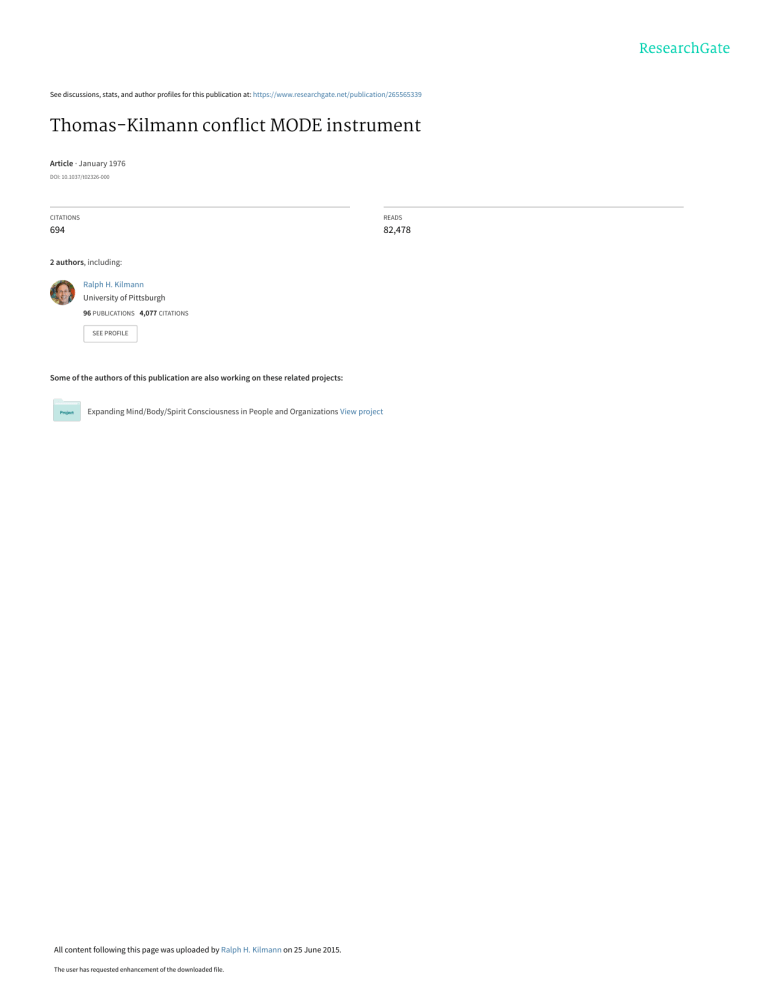
See discussions, stats, and author profiles for this publication at: https://www.researchgate.net/publication/265565339 Thomas-Kilmann conflict MODE instrument Article · January 1976 DOI: 10.1037/t02326-000 CITATIONS READS 694 82,478 2 authors, including: Ralph H. Kilmann University of Pittsburgh 96 PUBLICATIONS 4,077 CITATIONS SEE PROFILE Some of the authors of this publication are also working on these related projects: Expanding Mind/Body/Spirit Consciousness in People and Organizations View project All content following this page was uploaded by Ralph H. Kilmann on 25 June 2015. The user has requested enhancement of the downloaded file. Thomas-Kilmann Conflict Mode Instrument PROFILE AND INTERPRETIVE REPORT Kenneth W. Thomas and Ralph H. Kilmann Report prepared for ዊዊዊዊ ዊዊዊዊዊዊ May 1, 2008 CPP, Inc. | 800-624-1765 | www.cpp.com Thomas-Kilmann Conflict Mode Instrument Profile and Interpretive Report Copyright 2001, 2007 by Xicom, Incorporated. Xicom, Incorporated, is a subsidiary of CPP, Inc. All rights reserved. The CPP logo is a registered trademark and the TKI logo is a trademark of CPP, Inc. ዊዊዊዊዊዊዊዊዊዊዊ MAY 1, 2008. . . . . . . . . . . . . . . . . . . . . . . . . . . . . . . . . . . . . . . . . . . . . . . . . . . . . . . . . . . . . . . . . . . . . . . . . . . . . . . . . . . . . . . . . . . . . . . . Page 2 TKI PROFILE & INTERPRETIVE REPORT The Five Conflict-Handling Modes COMPETING ASSERTIVENESS A S S E R TIV E The Thomas-Kilmann Conflict Mode Instrument (TKI) assesses an individual’s behavior in conflict situations—that is, situations in which the concerns of two people appear to be incompatible. In conflict situations, we can describe a person’s behavior along two basic dimensions*: (1) assertiveness, the extent to which the individual attempts to satisfy his or her own concerns, and (2) cooperativeness, the extent to which the individual attempts to satisfy the other person’s concerns. These two dimensions of behavior can be used to define five methods of dealing with conflict. These five conflict-handling modes are shown below: COLLABORATING UN AS S ER TI VE COMPROMISING AVOIDING ACCOMMODATING UNC O O P ER A TIVE C O O PER A TIV E COOPERATIVENESS *This two-dimensional model of conflict-handling behavior is adapted from “Conflict and Conflict Management” by Kenneth Thomas in The Handbook of Industrial and Organizational Psychology, edited by Marvin Dunnette (Chicago: Rand McNally, 1976). Another valuable contribution in this field is the work by Robert Blake and Jane Mouton in The Managerial Grid (Houston: Gulf Publishing, 1964, 1994). ዊዊዊዊዊዊዊዊዊዊዊ MAY 1, 2008. . . . . . . . . . . . . . . . . . . . . . . . . . . . . . . . . . . . . . . . . . . . . . . . . . . . . . . . . . . . . . . . . . . . . . . . . . . . . . . . . . . . . . . . . . . . . . . . Page 3 TKI PROFILE & INTERPRETIVE REPORT C O M P E T I N G Competing is assertive and uncooperative, a power-oriented mode. When competing, an individual pursues his or her own concerns at the other person’s expense, using whatever power seems appropriate to win his or her position. Competing might mean standing up for your rights, defending a position you believe is correct, or simply trying to win. C O L L A B O R A T I N G Collaborating is both assertive and cooperative. When collaborating, an individual attempts to work with the other person to find a solution that fully satisfies the concerns of both. It involves digging into an issue to identify the underlying concerns of the two individuals and to find an alternative that meets both sets of concerns. Collaborating between two persons might take the form of exploring a disagreement to learn from each other’s insights, resolving some condition that would otherwise have them competing for resources, or confronting and trying to find a creative solution to an interpersonal problem. C O M P R O M I S I N G Compromising is intermediate in both assertiveness and cooperativeness. When compromising, the objective is to find an expedient, mutually acceptable solution that partially satisfies both parties. Compromising falls on a middle ground between competing and accommodating, giving up more than competing but less than accommodating. Likewise, it addresses an issue more directly than avoiding but doesn’t explore it in as much depth as collaborating. Compromising might mean splitting the difference, exchanging concessions, or seeking a quick middle-ground position. A V O I D I N G Avoiding is unassertive and uncooperative. When avoiding, an individual does not immediately pursue his or her own concerns or those of the other person. He or she does not address the conflict. Avoiding might take the form of diplomatically sidestepping an issue, postponing an issue until a better time, or simply withdrawing from a threatening situation. A C C O M M O D A T I N G Accommodating is unassertive and cooperative—the opposite of competing. When accommodating, an individual neglects his or her own concerns to satisfy the concerns of the other person; there is an element of self-sacrifice in this mode. Accommodating might take the form of selfless generosity or charity, obeying another person’s order when you would prefer not to, or yielding to another’s point of view. ዊዊዊዊዊዊዊዊዊዊዊ MAY 1, 2008. . . . . . . . . . . . . . . . . . . . . . . . . . . . . . . . . . . . . . . . . . . . . . . . . . . . . . . . . . . . . . . . . . . . . . . . . . . . . . . . . . . . . . . . . . . . . . . . Page 4 TKI PROFILE & INTERPRETIVE REPORT Your TKI Profile Your profile of TKI scores, shown below, indicates the repertoire of conflict-handling modes you use in the kinds of conflicts you face. Your scores are arranged in descending order by percentile, with your highest score indicating your most frequently used conflict mode. MODE RAW SCORE PERCENTILE SCORE 0% 25% 75% LOW COLLABORATING 11 COMPETING 6 ACCOMMODATING 5 AVOIDING 4 COMPROMISING 4 MEDIUM 100% HIGH 99% 69% 46% 22% 7% Your raw score on each conflict-handling mode is simply the number of times you chose a TKI statement for that mode. More important are your percentile scores. These show how your raw scores compare to those of a representative sample of 8,000 employed adults who have already taken the TKI.* Your percentile scores show the percentage of people in the sample who scored the same as or lower than you on each mode. Your profile shows that you scored highest on collaborating, where your score of 11 gave you a percentile score of 99. This means you scored higher than 99 percent of the people in the sample on collaborating. In contrast, you scored lowest on compromising, where you scored higher than only 7 percent of the sample. The solid vertical lines at the 25th and 75th percentiles separate the middle 50 percent of the scores on each mode from the top 25 percent and the bottom 25 percent. Scores that fall in the top 25 percent are considered high. Similarly, scores that fall in the bottom 25 percent are considered low. Scores that fall in the middle 50 percent are considered medium. Look at your scores to see where they fall within this range. *The norm sample consisted of 4,000 women and 4,000 men, ages 20 through 70, who were employed full time in the United States. Data were drawn from a database of 59,000 cases collected between 2002 and 2005 and were sampled to ensure representative numbers of people by organizational level and race/ethnicity. ዊዊዊዊዊዊዊዊዊዊዊ MAY 1, 2008. . . . . . . . . . . . . . . . . . . . . . . . . . . . . . . . . . . . . . . . . . . . . . . . . . . . . . . . . . . . . . . . . . . . . . . . . . . . . . . . . . . . . . . . . . . . . . . . Page 5 TKI PROFILE & INTERPRETIVE REPORT Interpreting Your Scores When you look at your profile on the TKI, you probably want to know, “What are the correct answers?” In the case of conflict-handling behavior, there are no right or wrong answers. All five modes are useful in some situations: each represents a set of useful social skills. Our conventional wisdom recognizes, for example, that often “Two heads are better than one” (collaborating). But it also says, “Kill your enemies with kindness” (accommodating), “Split the difference” (compromising), “Leave well enough alone” (avoiding), and “Might makes right” (competing). The effectiveness of a given conflict-handling mode depends on the requirements of the specific situation and the skill with which you use that mode. You are capable of using all five conflict-handling modes; you cannot be characterized as having a single, rigid style of dealing with conflict. However, most people use some modes more readily than others, develop more skills in those modes, and therefore tend to rely on them more heavily. Many have a clear favorite. The conflict behaviors you use are the result of both your personal predispositions and the requirements of the situations in which you find yourself. The following pages provide feedback on your conflict-handling modes as indicated by your TKI scores, beginning with your most frequently used mode, collaborating. To help you judge how appropriate your use of the five modes is for your situation, this section lists a number of uses for each mode. The uses are based on lists generated by company presidents. In addition, because your predispositions may lead you to rely on some conflict behaviors more or less than necessary, this section also lists some diagnostic questions concerning warning signs for the overuse or underuse of each mode. ዊዊዊዊዊዊዊዊዊዊዊ MAY 1, 2008. . . . . . . . . . . . . . . . . . . . . . . . . . . . . . . . . . . . . . . . . . . . . . . . . . . . . . . . . . . . . . . . . . . . . . . . . . . . . . . . . . . . . . . . . . . . . . . . Page 6 TKI PROFILE & INTERPRETIVE REPORT Collaborating Percentile: 99% Range: High Uses You may be using this mode most frequently because of the circumstances you face. A group of company presidents identified the following situations as times when collaborating is especially useful and effective: When you need to find an integrative solution and the concerns of both parties are too important to be compromised When your objective is to learn and you wish to test your assumptions and understand others' views When you want to merge insights from people with different perspectives on a problem When you want to gain commitment by incorporating others’ concerns into a consensual decision When you need to work through hard feelings that have been interfering with a relationship Collaborating as a Style Your frequent use of collaborating may also be part of a collaborating style you have developed to deal with conflict. Styles are rooted in personal beliefs, values, and motives that “push” one’s conflict behavior in a consistent direction. Collaborators tend to see conflicts as problems to be solved, wanting quality decisions that truly resolve the issues. They believe in the power of consensus and in sharing information and understandings. They regard teammates as allies and tend to see people outside the team as potential allies. They build on others’ ideas and listen well. Collaborators value innovation, open-mindedness, learning, and consensus. They look for the value in what others say and combine that with their own insights to find win-win solutions.* *This style description is adapted with permission from Introduction to Conflict and Teams by Kenneth W. Thomas and Gail Fann Thomas (Mountain View, CA: CPP, Inc., 2004). ዊዊዊዊዊዊዊዊዊዊዊ MAY 1, 2008. . . . . . . . . . . . . . . . . . . . . . . . . . . . . . . . . . . . . . . . . . . . . . . . . . . . . . . . . . . . . . . . . . . . . . . . . . . . . . . . . . . . . . . . . . . . . . . . Page 7 TKI PROFILE & INTERPRETIVE REPORT Contributions of a Collaborating Style Collaborators are helpful in reaching win-win solutions that provide a long-term resolution to a conflict issue. They ask questions, listen to other points of view, and try to incorporate those viewpoints into a richer, shared understanding. In the process, they aid open communication and learning. Often, collaborators are able to find superior, high-quality solutions to important issues. They may be sources of creativity and innovation. They help people air diverse views without putting anyone on the defensive. Questions to Ask The danger in any style is that you may use your preferred mode out of habit—even when it is not the most appropriate mode. Because you scored in the high range on collaborating, there is a good chance that you are overusing this conflict mode and underusing others. To help you determine if you are overusing collaborating, consider the following questions: Signs of overuse Do you sometimes spend time discussing issues in depth that don’t seem to warrant it? Collaboration takes time and energy—perhaps the scarcest organizational resources. Trivial problems don’t require optimal solutions, and not all personal differences need to be hashed out. The overuse of collaboration and consensual decision making sometimes represents a desire to minimize risk—by diffusing responsibility for a decision or by postponing action. Does your collaborative behavior fail to elicit collaborative responses from others? The exploratory and tentative nature of some collaborative behavior may make it easy for others to disregard your overtures or take advantage of the trust and openness you display. You may be missing some cues that would indicate the presence of defensiveness, strong feelings, impatience, competitiveness, or conflicting interests. In contrast, the fact that you scored high on collaborating makes it unlikely that you are underusing this mode. However, you may be interested in these signs of underuse in others: Signs of underuse Having difficulty seeing differences as opportunities for joint gain, learning, or problem solving. Although conflict situations often involve threatening or unproductive aspects, approaching all conflicts with pessimism can prevent people from seeing collaborative possibilities and thus deprive them of the mutual gains and satisfactions that accompany successful collaboration. Finding that others are uncommitted to one’s decisions or policies. Perhaps their concerns are not being incorporated into those decisions or policies. ዊዊዊዊዊዊዊዊዊዊዊ MAY 1, 2008. . . . . . . . . . . . . . . . . . . . . . . . . . . . . . . . . . . . . . . . . . . . . . . . . . . . . . . . . . . . . . . . . . . . . . . . . . . . . . . . . . . . . . . . . . . . . . . . Page 8 TKI PROFILE & INTERPRETIVE REPORT Competing Percentile: 69% Range: Medium Uses When quick, decisive action is vital—for example, in an emergency On important issues when unpopular courses of action need implementing—for example, cost cutting, enforcing unpopular rules, discipline On issues vital to company welfare when you know you’re right When you need to protect yourself from people who take advantage of noncompetitive behavior Questions to Ask Because you scored in the medium range on competing, there is little reason to suspect that you overuse or underuse this mode in general. However, the questions below can help you determine if you are overusing or underusing competing in specific situations. Signs of overuse Are you surrounded by “yes” people? If so, perhaps it’s because they have learned that it’s unwise to disagree with you or have given up trying to influence you. This closes you off from information. Are others afraid to admit ignorance and uncertainties to you? In a competitive climate, one must fight for influence and respect, acting more certain and confident than one feels. This means that people are less able to ask for information and opinions—they are less likely to learn. Signs of underuse Do you often feel powerless in situations? You may be unaware of the power you have, unskilled in its use, or uncomfortable with the idea of using it. This may hinder your effectiveness by restricting your influence. Do you sometimes have trouble taking a firm stand, even when you see the need? Sometimes concerns for others’ feelings or anxieties about the use of power cause people to vacillate, which may result in postponing the decision and adding to the suffering and/or resentment of others. ዊዊዊዊዊዊዊዊዊዊዊ MAY 1, 2008. . . . . . . . . . . . . . . . . . . . . . . . . . . . . . . . . . . . . . . . . . . . . . . . . . . . . . . . . . . . . . . . . . . . . . . . . . . . . . . . . . . . . . . . . . . . . . . . Page 9 TKI PROFILE & INTERPRETIVE REPORT Accommodating Percentile: 46% Range: Medium Uses When you realize that you are wrong—to allow a better solution to be considered, to learn from others, and to show that you are reasonable When the issue is much more important to the other person than it is to you—to satisfy the needs of others and as a goodwill gesture to help maintain a cooperative relationship When you want to build up social credits for later issues that are important to you When you are outmatched and losing and more competition would only damage your cause When preserving harmony and avoiding disruption are especially important When you want to help your employees develop by allowing them to learn from their mistakes Questions to Ask Because you scored in the medium range on accommodating, there is little reason to suspect that you overuse or underuse this mode in general. However, the questions below can help you determine if you are overusing or underusing accommodating in specific situations. Signs of overuse Do you feel that your ideas and concerns sometimes don’t get the attention they deserve? Deferring too much to the concerns of others can deprive you of influence, respect, and recognition. It can also deprive the organization of your potential contributions. Is discipline lax? Although discipline for its own sake may be of little value, some rules and procedures are crucial and need to be enforced. Accommodating on these issues may harm you, others, or the organization. Signs of underuse Do you sometimes have trouble building goodwill with others? Accommodation on minor issues that are important to others is a gesture of goodwill. Do others sometimes seem to regard you as unreasonable? Do you occasionally have trouble admitting when you are wrong? Do you recognize legitimate exceptions to the rules? Do you know when to give up? ዊዊዊዊዊዊዊዊዊዊዊ MAY 1, 2008. . . . . . . . . . . . . . . . . . . . . . . . . . . . . . . . . . . . . . . . . . . . . . . . . . . . . . . . . . . . . . . . . . . . . . . . . . . . . . . . . . . . . . . . . . . . . . . . Page 10 TKI PROFILE & INTERPRETIVE REPORT Avoiding Percentile: 22% Range: Low Uses When an issue is unimportant or when other, more important issues are pressing When you perceive no chance of satisfying your concerns—for example, when you have low power or you are frustrated by something that would be very difficult to change When the potential costs of confronting a conflict outweigh the benefits of its resolution When you need to let people cool down—to reduce tensions to a productive level and to regain perspective and composure When gathering more information outweighs the advantages of an immediate decision When others can resolve the issue more effectively When the issue seems tangential or symptomatic of another, more basic issue Questions to Ask Because you scored low on avoiding, there is a good chance that you are underusing this mode. To help you determine whether that is the case, consider the following questions: Signs of underuse Do you sometimes find yourself hurting people’s feelings or stirring up hostilities? You may need to exercise more discretion and tact, framing issues in nonthreatening ways. Do you sometimes feel harried or overwhelmed by a number of issues? You may need to devote more time to setting priorities—that is, deciding which issues are relatively unimportant and perhaps delegating them to others. In contrast, the fact that you scored low on avoiding makes it unlikely that you are overusing this mode. However, you may be interested in these signs of overuse in others: Signs of overuse Causing coordination to suffer because people have trouble getting one’s input on issues. Creating an atmosphere of “walking on eggshells.” Sometimes a dysfunctional amount of energy is devoted to caution and avoiding issues, indicating that those issues need to be faced and resolved. Decisions on important issues getting made by default. ዊዊዊዊዊዊዊዊዊዊዊ MAY 1, 2008. . . . . . . . . . . . . . . . . . . . . . . . . . . . . . . . . . . . . . . . . . . . . . . . . . . . . . . . . . . . . . . . . . . . . . . . . . . . . . . . . . . . . . . . . . . . . . . Page 11 TKI PROFILE & INTERPRETIVE REPORT Compromising Percentile: 7% Range: Low Uses When goals are moderately important but not worth the effort or the potential disruption involved in using more assertive modes When two opponents with equal power are strongly committed to mutually exclusive goals—as in labor–management bargaining When you want to achieve a temporary settlement of a complex issue When you need to arrive at an expedient solution under time pressure As a backup mode when collaboration or competition fails Questions to Ask Because you scored low on compromising, there is a good chance that you are underusing this mode. To help you determine whether that is the case, consider the following questions: Signs of underuse Do you sometimes find yourself too sensitive or embarrassed to engage in the give-and-take of bargaining? This reticence can keep you from getting a fair share in negotiations—for yourself, your team, or your organization. Do you sometimes find it difficult to make concessions? Without this safety valve, you may have trouble gracefully getting out of mutually destructive arguments, power struggles, and so on. In contrast, the fact that you scored low on compromising makes it unlikely that you are overusing this mode. However, you may be interested in these signs of overuse in others: Signs of overuse Concentrating so heavily on the practicalities and tactics of compromise that one loses sight of larger issues. Neglected issues may include principles, values, long-term objectives, or company welfare. Creating a cynical climate of gamesmanship. An emphasis on bargaining and trading may create a climate that undermines interpersonal trust and deflects attention from the merits of the issues. © Full copyright information appears on page 1. View publication stats
